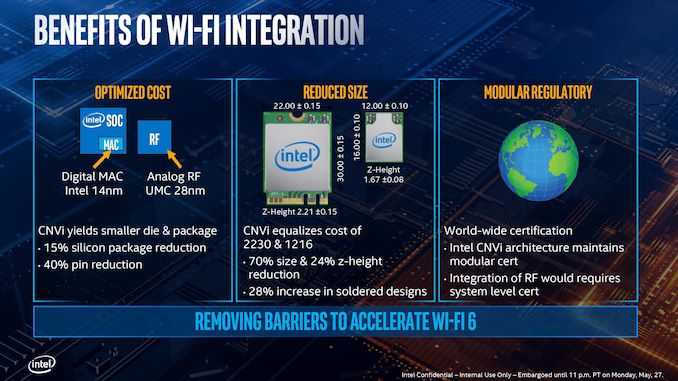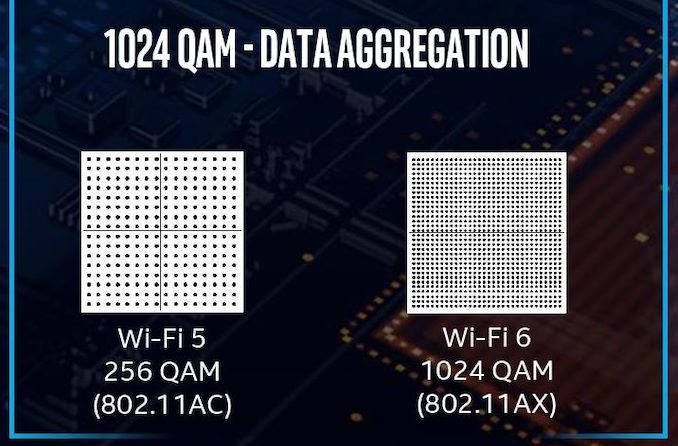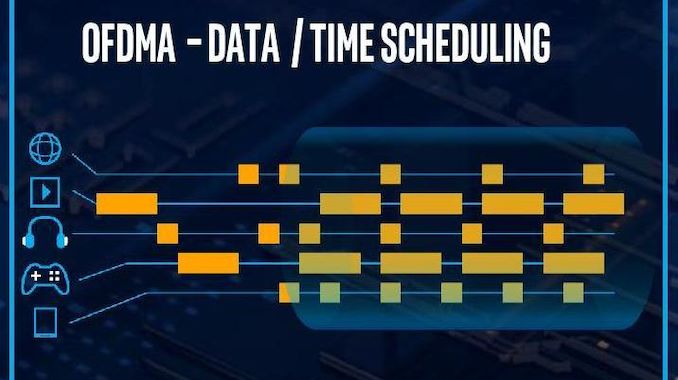Examining Intel's Ice Lake Processors: Taking a Bite of the Sunny Cove Microarchitecture
by Dr. Ian Cutress on July 30, 2019 9:30 AM EST- Posted in
- CPUs
- Intel
- 10nm
- Microarchitecture
- Ice Lake
- Project Athena
- Sunny Cove
- Gen11
Wi-Fi 6: Implementing AX over AC*
In consumer products, Intel has been placing its new Wi-Fi initiative into every chipset it can find. We’ve seen CNVi-enabled solutions occur on the desktop and in the notebook space for almost two years now, with the goal to make high-performance and low-power Wi-Fi ubiquitous, and to push Intel’s wireless solutions everywhere. Ice Lake is where Intel enables Wi-Fi 6 in such a solution.
If you’ve never come across the term CNVi before, it is Intel’s proprietary interface link and controller which connects the logic parts of the wireless connection on the chipset to the antenna and radio frequency analog parts which are found on a different module. This allows Intel’s partners to use different antenna ‘RF’ modules depending on what it wants to support, such as single antenna designs, dual antenna designs, or higher bandwidth modes.
Because CNVi is a proprietary interface, Intel has no plans to license it, and therefore the only RF modules you can buy to support it come from Intel. Intel states that its CNVi solution enables the high frequency digital logic to be built on its 14nm process with the chipset, and the RF analog side can be built on 28nm UMC which is better for analog signals and performance than any of Intel’s currently available manufacturing processes. Overall Intel states that using an external RF chip in this fashion affords a 15% silicon package reduction and a 40% pin reduction.
CNVi RF modules can either be an M.2 module (2230 = 22mm x 30mm) or as a soldered module (1216), which respectively allows for modularity, or for decreasing z-height for thin and light designs. Intel also states that this method of supplying the Wi-Fi, as separate digital and analog silicon, allows Wi-Fi certification to be done at the module level, rather than at the system level, simplifying the process for its partners.
As an overarching technology, Wi-Fi 6 promises better bandwidth than standard Wi-Fi 5, as well as support for more devices on the same network. Technically this increased bandwidth comes down to data/time aggregation through the air as a benefit of OFDMA support, as well as 1024-QAM signaling design rather than 256-QAM signaling for increased throughput.
Wi-Fi 6 also has a lot of additional optional elements to the standard, which Intel believes will cause a good deal of confusion in the market. Naturally, Intel suggests that its partners that use a CNVi Wi-Fi 6 implementation also promote Wi-Fi 6 access points built on Intel’s platforms for simpler integration.
At this point in time, there are two main Wi-Fi 6 controllers: Intel’s AX200/AX201 2x2 CNVi module which uses the on-die enhancements, and Rivet Network’s AX1650 M.2 module which doesn’t use any of the on-die enhancements as it connects through a PCIe lane on the chipset. Technically both are built with the same silicon, as the companies are working together on the design, however Rivet is implementing its own acceleration techniques due to engines inside the hardware.
*The asterisk in the title of this page is because you still need external hardware in order to enable it, and to do it in the best way requires Intel-only hardware. You can use other vendor hardware, but you don’t need something special on the SoC to enable that.













107 Comments
View All Comments
notashill - Tuesday, July 30, 2019 - link
Are those RAM/SSD targets really "greater than" 8GB/256GB or is it supposed to be "greater than or equal to"?Either way I would love to see an end to companies having >$1000 machines with pathetically low RAM/storage and then charging 500%+ markups to upgrade them to something decent. Like Microsoft's $1200 to go from 4/128 to 16/512.
mkozakewich - Wednesday, July 31, 2019 - link
I can't believe Microsoft has been using 4 GB as their base amount for the last six years. At some point it becomes insulting.repoman27 - Tuesday, July 30, 2019 - link
“Intel uses the ‘U’ designation for anything from 9W to 28W TDP, which covers all the mobile ultra-premium devices.”No they don’t. 9W are Y Series, 15 and 28W are U Series. This is all clearly stated in Intel’s publicly available product briefs for 10th Generation Core processors.
HStewart - Tuesday, July 30, 2019 - link
I be curious for more information on the Y processors - what the performance difference between Y and U. But it looks like these Ice Lake chips are designed for Ultraportable machines and not designed to replace to higher end ones - even like my Dell XPS 15 2in1 - I am really curious about that replacement - it's GPU is probably short lived possibly in updated higher voltage Ice Lake with Gen 11 graphics or new version with Xe graphics. I also have a Dell XPS 13 2in1 with Y processor - I am actually bringing it to meeting today - it is lightweight and does not really need that much power for what I using it for. I think it will be very interesting to compare this new XPS 13 2in1 and the existing XPS 15 2in1 - yes 15 2in1 has faster processor - but it not Ice Lake and that could make a huge difference.Hixbot - Tuesday, July 30, 2019 - link
4.2% annual IPC growth doesn't sound great but it is better than anything we've seen since SandyBridge.Targon - Tuesday, July 30, 2019 - link
And that should make people question the claims about performance increases. Mind you, how much performance has been lost on Intel chips due to the security issues? Intel may be comparing theoretical performance increases, without disclosing the fact that first through 9th generation have actually lost performance since launch due to security mitigations.So, +18% IPC, but -20% due to security mitigations for issues that are still there. Has Intel actually fixed the problems with the memory controller and other problems that allow for Meltdown and the other problems, rather than mitigating around the problem? If a problem has existed since first generation Core processors that turns out to be a design flaw, that also shows that the fundamental core design hasn't changed all THAT much.
rahvin - Wednesday, July 31, 2019 - link
Meltdown and some of the first spectre mitigations are going to be fixed in the hardware. Later spectre variants are probably only fixed in microcode and software.Where that line is drawn is going to be determined by when they froze the physical design for tapeout.
eek2121 - Wednesday, July 31, 2019 - link
I'm not knocking Intel on the IPC growth. If they had an 18% increase, great for them! However, mobile Intel CPUs of any variant (U, HK, Y, etc.) are much slower than their desktop counterparts. My Core i7 2600k absolutely destroys the 6700HK in my laptop. Laptops in general are designed to be low power devices, so performance is never the number one factor in designing a laptop, even on the high end. The only exception to this is the so called 'desktop replacements' that weigh a ton, have desktop class hardware, and basically need to be plugged in to not have the battery die after an hour.That's also the reason I take this announcement with a grain of salt. 18% on mobile is one thing. 18% on the desktop is something else. As I've mentioned to people here and elsewhere, the smaller the process, the harder it is to maintain high clock speeds. Also, from reading certain documentation, it seems that part of that 18% is counting the addition of AVX-512. I could be mistaken though.
erple2 - Wednesday, July 31, 2019 - link
Wow, really? That has not been my experience at all. My 6700hq has generally been (usually significantly) better performing than my 2600k for the vast majority of tasks I've thrown at it.jospoortvliet - Monday, August 5, 2019 - link
Any task that requires sustained compute will of course suffer on thr lower power budget on mobile. But tasks which require short bursts of activity will do better thanks to vastly improved turbo since the 2600k. So depending on what you do your impression might very well be accurate.